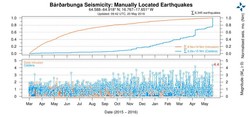
On the Bárðarbunga earthquakes
Seismic moment release on the caldera ring fault
Seismic measurements around the Bárðarbunga volcano show that the seismic moment release on the caldera ring fault has been gradually increasing since mid September 2015. This means that stronger earthquakes than before have been detected in the last months. Despite the increasing activity, there are currently no signs of volcanic tremor.
The analysis of the earthquake data suggests that the movement on the fault is opposite to what it was during the subsidence period during the Holuhraun eruption. Continuous GPS measurements show movements away from Bárðarbunga, suggesting inflation. Satellite images processed by the University of Iceland show that hydrothermal cauldrons in the ice at the caldera rim have been deepening, which might reflect increasing geothermal activity.
Since the end of the Holuhraun eruption in February 2015, 45 earthquakes of magnitude larger than M3 have been detected around the Bárðarbunga caldera, 42 of them since 1st September 2015 and 31 since 1st January 2016. The strongest events were M4.2 on 8th April 2016 and M4.4 on 20th May 2016. Despite the increasing activity, there are currently no signs of volcanic tremor.
Increasing activity under Bárðarbunga in the last months might reflect magma accumulation below the volcano. However, other explanations have been considered; for example increasing water pressure in the hydrothermal system inside the caldera, pressure changes due to changing ice load or increased friction on the ring fault due to increasing magma pressure.
The Icelandic Meteorological Office is following the activity 24/7 and will update the public in case of any changes.



